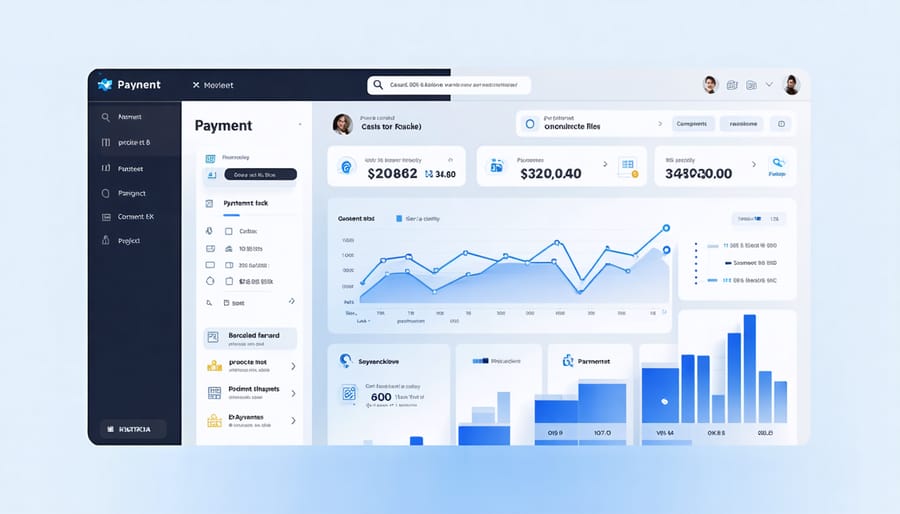Transform traditional construction financing through data-driven risk assessment models that leverage real-time project analytics and predictive modeling. Modern construction enterprises must secure financing for construction projects using sophisticated financial instruments that align with emerging market dynamics.
Integrate blockchain-enabled payment systems and smart contracts to streamline capital flow, reduce transaction costs, and enhance project transparency. This technological revolution in construction finance creates unprecedented opportunities for cost optimization and risk mitigation, while opening doors to alternative funding sources previously unavailable to the industry.
Digital transformation of financial operations, combined with sustainable building practices, positions construction firms to access green financing options and ESG-focused investment pools. These innovative funding mechanisms offer competitive advantages through lower interest rates, extended payment terms, and enhanced stakeholder confidence in project outcomes.
By leveraging these advanced financial strategies, construction professionals can establish robust capital structures that withstand market volatility while maintaining operational flexibility. This strategic approach ensures project viability and maximizes return on investment across the entire construction lifecycle.
Project-Specific Financing Models
Performance-Based Financing
Performance-based financing (PBF) represents a significant shift in construction project funding, linking capital disbursement directly to achieved milestones and measurable outcomes. This innovative approach incentivizes contractors and developers to meet or exceed predetermined performance metrics while providing investors with greater confidence in project execution.
Under a PBF framework, funding is released in tranches based on verified completion of specific project benchmarks. These may include meeting construction deadlines, achieving quality standards, implementing safety protocols, or reaching sustainability targets. For example, a commercial development might receive 20% of funding upon foundation completion, with subsequent disbursements tied to structural completion, building envelope installation, and systems integration.
Industry leaders have reported significant benefits from PBF implementation, including improved project efficiency, reduced delays, and enhanced quality control. A recent study of 150 commercial projects revealed that those utilizing PBF experienced 23% fewer timeline overruns compared to traditionally financed projects.
To implement PBF effectively, stakeholders must establish clear, measurable performance indicators at project inception. Digital monitoring tools and third-party verification systems play crucial roles in tracking progress and ensuring transparency. Regular audits and progress assessments help maintain accountability and provide documentation for funding releases.
However, successful PBF implementation requires robust project management systems and detailed documentation protocols. Organizations should consider implementing specialized software solutions to track metrics and generate performance reports efficiently.
Green Building Finance Programs
The construction industry has witnessed a significant surge in green building initiatives, supported by specialized financing programs designed to incentivize sustainable development. These programs offer attractive terms for financing energy efficiency projects and environmentally conscious construction ventures.
Leading financial institutions now provide preferential interest rates and extended repayment terms for projects that meet specific sustainability criteria, such as LEED certification requirements. The Property Assessed Clean Energy (PACE) program, for instance, enables building owners to finance up to 100% of energy efficiency improvements through property tax assessments, spreading costs over extended periods.
Green bonds have emerged as another powerful funding mechanism, allowing developers to access capital markets specifically for sustainable construction projects. These instruments typically offer lower borrowing costs while attracting environmentally conscious investors.
Additionally, government-backed initiatives provide tax incentives, grants, and rebates for sustainable building practices. The Department of Energy’s Better Buildings Initiative and various state-level programs offer substantial financial support for projects incorporating renewable energy systems, water conservation measures, and energy-efficient building materials.
Many utilities also participate by offering on-bill financing programs, allowing building owners to repay energy efficiency upgrades through their monthly utility bills, effectively creating a cash-flow-positive investment from day one.

Technology-Driven Financial Solutions
Digital Payment Platforms
The integration of digital construction finance solutions has transformed how construction companies manage their payment processes and cash flow. Modern digital payment platforms offer unprecedented efficiency, transparency, and control over financial transactions throughout the project lifecycle.
Leading construction firms are increasingly adopting cloud-based payment systems that facilitate real-time processing of contractor payments, supplier invoices, and project-related expenses. These platforms typically feature automated approval workflows, digital documentation management, and integrated compliance tracking, reducing payment processing time by up to 70% compared to traditional methods.
Mobile payment capabilities have become particularly valuable for on-site transactions, enabling immediate processing of material deliveries and subcontractor payments. This functionality has proven crucial for maintaining project momentum and strengthening supplier relationships through prompt payment execution.
Security features in modern payment platforms include multi-factor authentication, encryption protocols, and detailed audit trails, addressing common concerns about digital transaction safety. Integration capabilities with existing accounting and project management software ensure seamless data flow and accurate financial reporting.
Recent industry data indicates that construction companies utilizing digital payment platforms report a 45% reduction in payment-related delays and a 30% improvement in supplier satisfaction scores. The ability to track payment status in real-time has significantly reduced administrative burden while improving financial visibility across multiple projects.
For optimal implementation, construction companies should evaluate platforms based on their specific needs, including project volume, supplier network size, and existing technology infrastructure. Regular staff training and clear process documentation ensure maximum benefit from these digital tools.

Blockchain in Construction Finance
Blockchain technology is revolutionizing financial transactions in the construction industry by offering unprecedented levels of transparency, security, and efficiency. This distributed ledger technology creates an immutable record of all financial transactions, providing stakeholders with real-time visibility into project finances and payment flows.
Smart contracts, a key feature of blockchain technology, automate payment processes based on predefined milestones and conditions. When specific project requirements are met and verified, payments are automatically released to contractors and suppliers, reducing payment delays and disputes. This automation significantly decreases administrative overhead and accelerates the payment cycle.
Leading construction firms are implementing blockchain solutions for supply chain financing and vendor payments. For example, a major European construction company reported a 60% reduction in payment processing time after implementing a blockchain-based payment system. The technology also enables better tracking of materials and equipment purchases, ensuring transparency in procurement processes.
Blockchain’s application in construction finance extends to project funding through tokenization of real estate assets. This approach allows for fractional ownership and creates new opportunities for project financing by enabling smaller investors to participate in large-scale construction projects.
Security features inherent in blockchain technology help prevent fraud and unauthorized modifications to financial records. Each transaction is cryptographically sealed and verified by multiple nodes in the network, making it virtually impossible to alter historical records without detection.
As the technology matures, industry experts predict blockchain will become standard practice in construction finance, particularly for large-scale projects where multiple stakeholders require transparent financial oversight. Early adopters are already reporting improved cash flow management and reduced financial disputes through blockchain implementation.

Alternative Funding Sources
Crowdfunding and P2P Lending
Crowdfunding and peer-to-peer (P2P) lending platforms have emerged as viable alternatives for construction project financing, particularly for mid-sized developments and renovation projects. These digital platforms connect project developers directly with potential investors, bypassing traditional banking institutions and often reducing overall financing costs.
Notable construction crowdfunding platforms like Fundrise and RealtyMogul have successfully funded projects ranging from $500,000 to $5 million, with average returns of 8-12% for investors. These platforms typically operate on either an equity or debt-based model, allowing construction companies to choose the most suitable funding structure for their specific needs.
P2P lending platforms offer more streamlined approval processes compared to traditional banks, with decisions often made within 2-3 weeks. This accelerated timeline can be particularly advantageous for time-sensitive construction projects. However, interest rates tend to be higher than conventional loans, typically ranging from 8-15% depending on project risk assessment.
Case Study: The Madison Square Development in Denver successfully raised $2.8 million through crowdfunding in 2022, completing a mixed-use project 40% faster than traditional financing would have allowed. The project demonstrated how digital funding platforms can effectively complement traditional financing methods.
Key considerations for construction firms exploring these platforms include:
– Platform reputation and track record
– Fee structures and payment terms
– Regulatory compliance requirements
– Investor communication protocols
– Project milestone reporting obligations
Equipment Financing Solutions
In today’s dynamic construction landscape, innovative equipment financing solutions are revolutionizing how companies acquire and maintain their machinery fleet. Traditional equipment loans are giving way to more flexible arrangements, including equipment-as-a-service (EaaS) models, which allow contractors to access state-of-the-art machinery without substantial upfront costs.
Operating leases with technology-embedded solutions are gaining traction, offering predictive maintenance features and usage-based pricing. These smart leases integrate IoT sensors to monitor equipment performance, helping companies optimize utilization and reduce overall financing costs. Construction firms can now leverage real-time data to make informed decisions about equipment acquisition and replacement cycles.
Alternative financing options like sale-leaseback arrangements provide immediate working capital while maintaining equipment access. Equipment financing marketplaces are emerging as digital platforms, connecting contractors with multiple lenders to secure competitive rates and terms. These platforms often incorporate AI-driven credit assessment tools, streamlining the approval process.
Sustainable equipment financing programs are also becoming prevalent, offering preferential rates for eco-friendly machinery. Companies can benefit from tax incentives while meeting environmental compliance requirements. Joint venture equipment pools represent another innovative approach, allowing multiple contractors to share both equipment costs and utilization benefits.
For smaller contractors, embedded financing solutions through equipment manufacturers provide turnkey options with maintenance packages and flexible payment structures aligned with project timelines. This integrated approach simplifies fleet management while optimizing cash flow.
Risk Management Strategies
Insurance-Backed Financing
Insurance-backed financing has emerged as a sophisticated solution for construction projects, combining risk management with funding accessibility. This innovative approach leverages specialized insurance products to secure project financing, offering contractors and developers enhanced credibility with lenders while providing additional security layers for all stakeholders.
Performance bonds and surety products form the foundation of these arrangements, but newer products like subcontractor default insurance and project loss insurance are expanding the possibilities. These instruments not only protect against potential defaults but also serve as collateral alternatives, potentially reducing the capital requirements for project initiation.
Leading insurance providers now offer integrated packages that combine traditional construction insurance with financing components. These hybrid solutions can include features such as delayed premium payments, performance-linked terms, and risk-sharing arrangements that align with project milestones.
Recent market innovations include parametric insurance products that provide rapid, predefined payouts based on specific triggers, helping maintain project cash flow during unexpected events. This approach has proven particularly valuable for large-scale infrastructure projects where traditional financing might be constrained by risk factors.
The implementation of these insurance-backed financing solutions requires careful structuring and typically involves collaboration between insurance professionals, financial advisors, and legal experts to ensure optimal coverage and compliance.
Supply Chain Finance Solutions
Supply chain finance solutions are revolutionizing how construction companies manage their supplier relationships and cash flow. By implementing reverse factoring programs, contractors can extend their payment terms while ensuring suppliers receive prompt payment through third-party financial institutions. This approach significantly improves working capital management and strengthens supplier relationships.
Dynamic discounting platforms enable construction firms to offer early payments to suppliers in exchange for scaled discounts, creating a win-win situation for both parties. Suppliers benefit from improved cash flow, while construction companies can optimize their capital utilization and reduce supply chain risks.
Blockchain-based supply chain finance solutions are gaining traction, offering unprecedented transparency and security in payment processes. These systems automate payment triggers based on verified milestones, reducing administrative overhead and potential disputes. Leading construction firms report up to 30% reduction in financing costs through such innovative platforms.
Integration with project management software allows real-time tracking of supplier deliverables and automatic payment processing, streamlining the entire supply chain finance workflow. This technological convergence helps construction companies maintain healthy supplier relationships while optimizing their working capital position.
For optimal results, companies should establish clear supplier onboarding protocols and performance metrics to maximize the benefits of these financial solutions.
The construction industry stands at a pivotal moment in its financial evolution, with emerging technologies and innovative funding models reshaping traditional approaches to project financing. As we’ve explored throughout this article, the integration of digital platforms, sustainable financing options, and alternative funding mechanisms has created unprecedented opportunities for construction businesses to optimize their financial strategies.
The key takeaways emphasize the growing importance of flexibility and diversification in construction finance. Successful projects increasingly rely on a combination of traditional lending, private equity partnerships, and technology-driven solutions. The rise of green financing and ESG-focused investments signals a lasting shift toward sustainable construction practices, while blockchain technology and digital payment systems continue to streamline financial operations and improve transparency.
Looking ahead, the construction finance landscape will likely continue its rapid transformation. Industry experts predict increased adoption of automated financial management systems, broader implementation of real-time project tracking solutions, and greater integration of artificial intelligence in risk assessment and financial planning. Construction companies that embrace these innovations while maintaining sound financial fundamentals will be best positioned for success.
For construction professionals, staying informed about these evolving financial strategies and maintaining adaptability will be crucial. The future of construction finance lies in balancing innovative approaches with proven financial management practices, ensuring sustainable growth and project success in an increasingly complex market environment.

